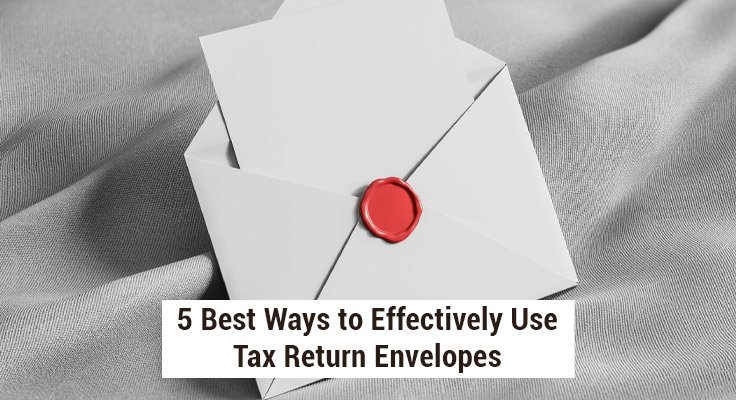Tax season is that time of the year that’s stressful for clients and tax professionals.
From gathering client documents to sending out vital tax returns, the humble envelope for tax returns can facilitate smooth communication. If done right, this may expedite document returns, guarantee privacy, and ultimately enhance the entire process of filing taxes.
The five best practices listed in this article can help your tax return envelopes serve their purpose.
1. Selecting the Proper Return Envelope Type for Taxes
Properly selecting the right return envelopes for tax professionals can make quite a difference regarding the feasibility and speed of document returns. Regarding sensitive information like taxes, your choice of envelope should meet convenience and security standards.
That said, different types of envelopes include:
- Stamped Reply Envelopes(SRE): The client can use them to return tax documents in a mailed envelope stamped with the appropriate postage. Many clients, especially during this mad period of paper shuffling, appreciate the convenience, as now they don’t have to worry about postage.
- Business Reply Envelopes(BRE): You can pay for postage only when the envelope is returned. It would be reasonably economical if one doesn’t expect all clientele to return them. They’re perfect for tax professionals with a large clientele where you expect documents to be returned at different intervals.
- Security-Tinted Envelopes: If confidential tax forms dealing with Social Security numbers or financial statements are sent, use security-tinted envelopes. These prevent any other person from viewing the envelope inside while in transit for added client security.
Getting the right kind of envelope will make it easier for clients to mail back those important tax documents and keep you organized during the tax season frenzy.
2. Ensure Secure Handling of Sensitive Documents
Tax return envelopes often bear personal and sensitive information. Document security, therefore, is one of the major concerns for any tax professional.
- Security Features: These envelopes contain a tamper-evident seal, such as self-adhesive or water-activated strips, instead of ordinary envelopes. This will help in keeping sensitive information confidential.
- Security-Tinted Envelopes: Most of these envelopes have an inside pattern that blocks the visibility of their contents from outside the envelope. This is important if personal information is included with the tax forms, such as Social Security or bank account numbers.
- Document Tracking: You may want to use trackable envelopes for large-value returns or otherwise important originals. They provide a layer of security because you and your clients can track the envelope to ensure it arrives safely at a certain location.
These security measures will protect both your clients and your firm regarding sensitive documents related to tax returns
3. Explain and Elaborate Clearly
To the tax professional, clear instructions inside the envelope are just as important as the envelope itself. A poorly understood process leads to delays in document returns and frustrated clients.
To provide clear guidelines:
- Include Step-by-Step Instructions: Tax documents can be complex, and the client may not be entirely sure what needs to be returned. A simple checklist or set of instructions as to what’s needed will help to ensure that nothing is overlooked.
- Pre-addressed Return Envelope: Always fill out your address on the return envelope in advance, as this can save your clients from errors and delays in receiving the document. This tiny step reduces client confusion and can save much time.
- Reminders of Deadlines: Clients may have a lot on their hands, so reminding them when to return their tax documents will keep them in the know. A candid notice on the envelope, such as “Please return by March 15,” would instill urgency and ensure timely responses.
Giving clear and explicit instructions ensures clients know what is expected of them, thereby guiding you in avoiding unnecessary delays and omissions.
4. Optimize Envelope Design for Professionalism and Ease
Many of your clients face mountains of letters and documents during tax season. Therefore, it’s crucial to ensure that the envelope carrying your tax return stands out professionally so that it’s easy for a client to take action. For that, include:
- Custom-Branded Envelopes: Your firm’s logo, colors, and other branding aspects will provide a professional look that might just help assure the client that their correspondence is valid. This also enhances your firm’s brand recognition by making all your envelopes stand out from the rest of the mail.
- Attention-Grabbing Visual Cues: Add little yet efficient design touches: a striking “Tax Documents Enclosed” message or an urgent “Please Return by [Date]” callout. Such a little thing can often bring earlier responses.
- Practical Size: Ensure the envelope is the right size to accommodate your requested documents without folding or wrinkling them. Slightly large envelopes, like size 9×12, keep several documents ready inside for easy packaging and ensure their good condition upon arrival.
A well-designed envelope speaks to the professionalism and will entice clients to consider the enclosed documents important.
5. Test and Refine for Maximum Efficiency
Even in tax preparation, the work is never done. Testing all the different ways you use envelopes in preparing tax returns is a fabulous way to optimize for better results and sometimes even helps to raise your client satisfaction.
The more you test and fine-tune how you employ tax return envelopes in your practice, the further along your tax preparation will go towards complete efficiency, ensuring smoother interactions and happier clients.
Conclusion
Tax return envelopes are often the underappreciated but important pieces in tax preparation. With a proper type of envelope, with attention to security, clear instructions, design optimization, and constant testing and refinement of your approach, you will make document returns smoother, enhance professionalism, and be able to add up to a better client experience.
Also Read: All you need to know about Franchise Tax in Texas






















